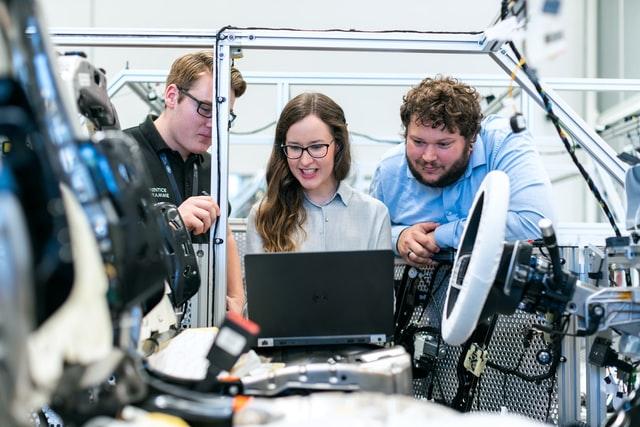Maybe you never heard of human-machine interfaces (HMI), but one thing for sure is that you encounter them pretty regularly. Most of the time HMI will be in the form of a screen. It is a system that lets humans interact with devices. In simpler terms, it’s a way to control a machine using input and output. Think of cell phones.
Input tells the device what to do and output keeps the user updated about its status. For instance, you can receive a message notifying you when your cell phone’s battery is low. The goal of a Human-Machine Interface is to make the experience for humans as seamless as possible.
The input device needs to be comfortable and familiar and the human user should have the shortest response time possible. It should also be easy to understand and use and should be simple to learn. In advanced-level applications, HMI will display information from input/output sensors and PLCs.
The information can be used for monitoring, tracking or even executing operations. An HMI can also display historical data and reports for authorized users. The technology behind HMIs is rapidly developing. The latest versions of human-machine interface systems utilize multitouch technologies.
By tapping and touching, users can control machines without even touching them. And since smartphones have become indispensable in everyday life, it was only a matter of time before mobile phones connected HMIs to them. The first computer-human interface was a type of command language interface.
In this early HMI, man used computer language to communicate with devices and he would enter specific tasks and sequences on a punch card and feed it into the machine. The device would then evaluate the information and deliver results. However, this early human-machine interface required a lot of training and required incredible memory.

This was also prone to error, making it less efficient than the modern system. Nowadays technological advancement has taken HMI to a whole new level. HMI technology is becoming ubiquitous. Humans can interact with a machine through various means, including touch screens and voice recognition. An interface allows humans to input information without looking away from a task.
HMIs can come in different forms, from standalone screens to a dashboard attached to another piece of equipment. They can also be tablet-like devices and their purpose is to display information and control machinery. With this technology, operators can monitor conveyor belts and adjust the temperature without having to use their hands.
HMI is an increasingly important part of industrial technology. The rise of the Industrial Internet of Things, the need for energy efficiency and other factors have led to the development of this device. The era of Industry 4.0 is also changing the human-machine interface industry. And industry 5.0 will take it to a whole new level.
High-quality human-computer interfaces improve user experience and boost productivity. Easy accessibility of data is essential for operators, which makes data sync with the system easy to access. High-performance devices allow operators to access important data without too much fuss.
This new wave of technology will encourage companies to develop new technological solutions for human-machine interaction. One of the hottest trends in HMI programming is remote monitoring. This technology will allow operators to monitor and control machinery performance from a remote location. This may become commonplace in the future.
Industry 4.0 is transforming the human-machine interaction process and smart CPSs will require new interfaces. This means that new HMI systems must be more sophisticated than ever to support remote service operations and increase the accuracy and speed of problem-solving.
Currently, developers are implementing new HMI technologies, including enhanced touch interfaces, voice interfaces, gestures and AR/VR tools. With these innovations, human-computer interfaces will become even more convenient to use. In addition to smarter machines, the technology allows companies to boost their productivity and efficiency.
Moreover, fast and intuitive interaction is also a trend in HMI programming. A user-friendly interface should be clean and uncluttered, allowing operators to focus on essential data and minimize distractions. The human-machine interface market is driven by the growing demands for improved efficiency, along with the emergence of new technologies such as mobile applications and IoT.

The presence of a few dominant manufacturers has also led to the development of new technologies. The key players are focused on innovation and new product developments, as well as acquisitions to remain competitive. They are also committed to addressing challenges facing the market.
In the long run, they can save a lot of time and effort. But, in the meantime, they can monitor and control every aspect of a manufacturing line. We are living in a time where humans and technology meet in a new exciting way. We use technology to connect with people, build communities and even communicate with one another.
Developing holographic technology is another promising way to create a user-friendly human-machine interface. With digital facsimiles of physical controls and projections of information, holographic human-machine interfaces will enable users to use tools that are not available in the real world.
They will be able to type in the air and perform many other tasks with the help of the machine’s virtual counterpart. Furthermore, the complexity of human-computer interactions will increase dramatically with the development of the Internet of Things. There is no single HMI that will make interaction seamless for all people involved.
HMIs at the factory level can streamline processes, reduce waste and increase profitability. As machines and edge-level HMIs become more powerful, they will be key to competition in real-time. Businesses must take the time to consider the future of these devices. If you want your factory to remain competitive and grow, consider using HMIs. They can make the difference between success and failure.
In addition to the growing complexity of human-machine interactions, advancing technology in this field is vital for the development of connected devices. For instance, wearable technology and the Internet of Things will require more complex computer-human interfaces that go beyond the graphical user interface.
HMI market research reports highlight the latest technology and innovation. They also examine historical market performance and identify leading technology suppliers. The benefits of these innovations extend to many different fields, including healthcare and consumer electronics. And these trends will continue to grow as technology progresses.

0 Comments